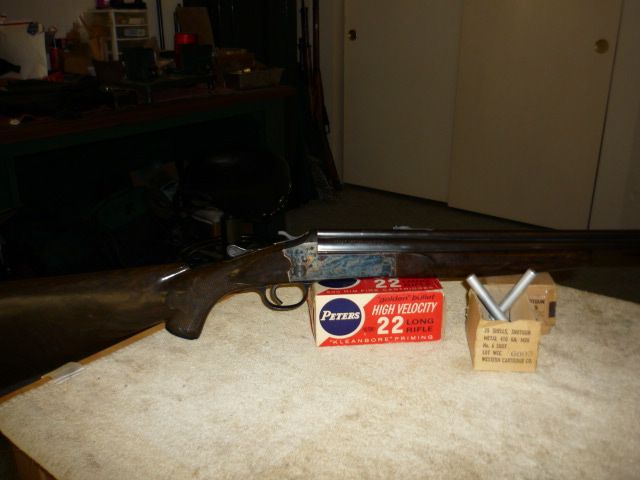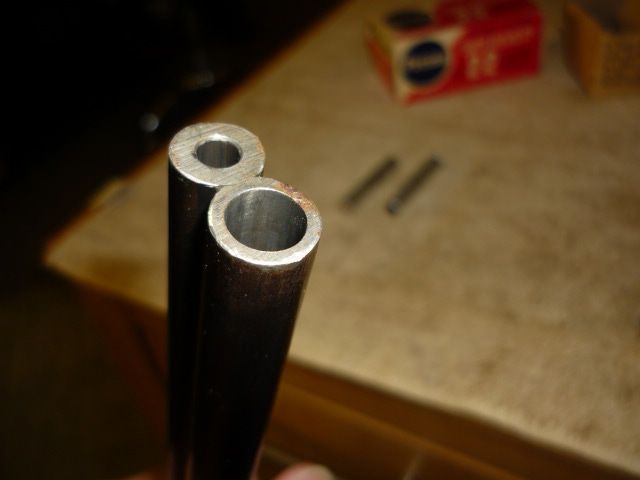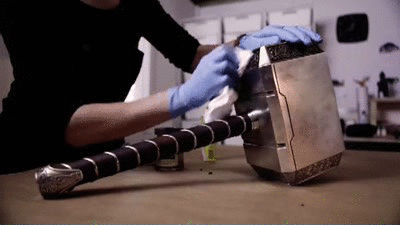After five years of being froze up tight, I finally got into my shotgun safe. This prized possession was buried in the back.
The Stevens .22/.410 was the grand daddy to the Savage/Stevens Model 24. Introduced in 1938, it was made until 1950 when Savage came out with the Model 24. The first ones made had walnut stocks until the war broke out. Lack of gunstock wood prompted Stevens to develop the plastic stocks called Tenite. The receivers were "real" color case hardened, not the acid washed faux color case of the later Model 24.
Some of these were bought for the Air Force as survival guns in B-29's. This one, serial number 493104, was issued to my uncle, Col. William L. Evans and his B-29.
Fast forward to post Korean War, he was ferrying B-29's to the Arizona bone yard, and by coincidence, ended up delivering his old plane. The gun was still in it. He asked if he could buy the still unfired Stevens, and they sold it to him for the whopping scrap price of $5!
To date, it's had one round of .22LR through it, I checked the crown for accuracy, and it went right in the 10 ring!
The ones that saw service, will have two distinctive traits.
Since neither the gun, nor the plane, were made to accommodate each other, the pilots found a spot in the airframe to wedge the gun in. The gun was about 1/2" to long to fit, so the end of the barrels were chop sawed in the maintenance shop, and a crude re-crown done with a hole reamer.
A distinctive scratch in the wood grain Tenite butt stock, from the airframe rivets, is the other. This has both.
They were issued with Western Cartridge Co. M35 3" .410 #6 shotshells, made of aluminum, red lacquered cardboard wad under a roll crimp.
Stevens and period ammo


Color case, Tenite wood grain, and USAF markings


Chop sawed muzzle and crown

The Stevens .22/.410 was the grand daddy to the Savage/Stevens Model 24. Introduced in 1938, it was made until 1950 when Savage came out with the Model 24. The first ones made had walnut stocks until the war broke out. Lack of gunstock wood prompted Stevens to develop the plastic stocks called Tenite. The receivers were "real" color case hardened, not the acid washed faux color case of the later Model 24.
Some of these were bought for the Air Force as survival guns in B-29's. This one, serial number 493104, was issued to my uncle, Col. William L. Evans and his B-29.
Fast forward to post Korean War, he was ferrying B-29's to the Arizona bone yard, and by coincidence, ended up delivering his old plane. The gun was still in it. He asked if he could buy the still unfired Stevens, and they sold it to him for the whopping scrap price of $5!
To date, it's had one round of .22LR through it, I checked the crown for accuracy, and it went right in the 10 ring!
The ones that saw service, will have two distinctive traits.
Since neither the gun, nor the plane, were made to accommodate each other, the pilots found a spot in the airframe to wedge the gun in. The gun was about 1/2" to long to fit, so the end of the barrels were chop sawed in the maintenance shop, and a crude re-crown done with a hole reamer.
A distinctive scratch in the wood grain Tenite butt stock, from the airframe rivets, is the other. This has both.
They were issued with Western Cartridge Co. M35 3" .410 #6 shotshells, made of aluminum, red lacquered cardboard wad under a roll crimp.
Stevens and period ammo


Color case, Tenite wood grain, and USAF markings


Chop sawed muzzle and crown






 ) so it'll be at the shoot.
) so it'll be at the shoot.




Comment